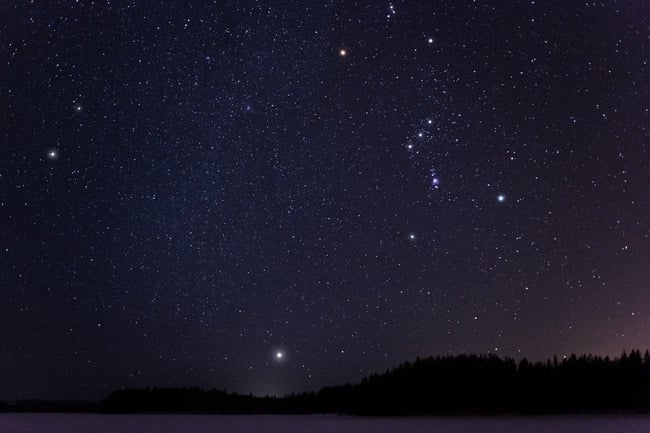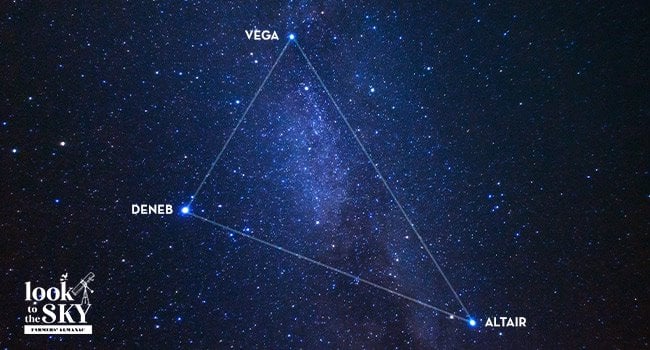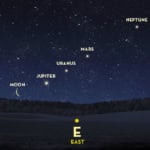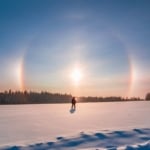The 10 Brightest Stars In The Sky

People often ask, “What’s the best way to get started in astronomy?” We recommend looking for the most brilliant, easiest to find stars. Here is a list of the 10 brightest stars in the sky that you can see at night no matter where you are in the Northern Hemisphere—whether you’re out in the countryside or deep in the heart of a city! We also included a “bonus” star everyone should know how to find. See how many you can find over the course of a year and try to catch them all.
Most of the brightest stars are best seen in the winter, but each season has special ones to spot. For instance: In the spring, look for Arcturus (#2) and Capella (#4); In the summer, look for Vega (#3) and Altair (#8). We hope this guide helps you get to know the sky better. If you have any questions, let us know in the comments below!
We consulted expert astronomer Dean Regas of the Cincinnati Observatory — the oldest observatory in the United States — to create this guide.
The 10 Brightest Stars In The Sky
The following list is in descending order, #1 being the brightest. Along with each star’s name, you will find its apparent magnitude. Magnitude is a numerical scale that describes how bright a celestial object appears to be. Negative numbers are brighter than positive ones. As a reference, the light of a full Moon is approximately -12.7 whereas the Sun is -26.74.
Psst … did you know that the best times for stargazing are around a new Moon?
Related: When Is The Next New Moon?
1. Sirius (Alpha Canis Majoris)
Sirius’ apparent magnitude is -1.46 — best seen in the winter (south).
The brightest star visible from Earth (other than the Sun) is Sirius. The ancients called it the “scorcher,” and it lives up to its name by blazing more than three times brighter than the second star on our list: Arcturus.
How to find Sirius: Connect the three stars in Orion’s Belt and continue that line of sight down and to the left. After traveling about 20 degrees in that direction, you will run into Sirius.
Note: The Sun is in fact the brightest star in the sky. Our list here identifies the brightest stars in the night sky in North America.

2. Arcturus (Alpha Bootis)
Arcturus’ apparent magnitude is -0.05 — best seen in the spring (Southeast), summer (south), and fall (west).
The name Arcturus comes from Latin and means “guardian of the bear.” The name is apt since the star lies relatively close to the major constellation Ursa Major. Polynesian astronomers call it Hōkūleʻa, meaning the “star of joy,” and used it as a guide star to help them navigate around the Pacific Ocean.
How to find Arcturus: First find the Big Dipper and trace out the three stars that form its curved handle. Continue the arc of those stars away from the Big Dipper for 30 degrees until you run into Arcturus. If you “follow the arc to Arcturus,” then you will easily find this bright star.
3. Vega (Alpha Lyrae)
Vega’s apparent magnitude is 0.03 — best seen in the summer (east) and fall (west/northwest).
Vega is definitely the star of the summer skies. This brilliant blue star rides high in the summer nights and is about 25 light years from Earth.
How to Find Vega: You can first spy Vega during the month of May in the northeastern sky after dark. It forms the top corner of the Summer Triangle (a noticeable star pattern) in May, June, and July. Each month it will appear higher in the east until it is nearly straight overhead in August and September. During the fall months of October and November, Vega will be lower in the western and northwestern sky.
4. Capella (Alpha Aurigae)
Capella’s apparent magnitude is 0.08 — best seen in the fall (northeast) and spring (northwest).
Capella is the brightest star in the pentagon-shaped constellation Auriga. In Greek its name means “little she-goat.” It was called the Heart of Brahma in India. And in South America this star was one of the favorites among shepherds, who called it Colca.
How to Find Capella: Capella and Sirius are the stars at the pointy ends of the Winter Football (a huge ring of bright stars visible in the winter sky). During the heart of winter, if you lie on the ground and look straight up, Capella will greet you.
5. Rigel (Beta Orionis)
Rigel’s apparent magnitude is 0.18 — best seen in the winter (south).
The brightest star in Orion, and the fifth brightest star in the Northern Hemisphere, is named Rigel. This name can be loosely translated as “left foot of the central one.” It twinkles blue-white in color and makes a great contrast to orange Betelgeuse on the other side of the constellation.
How to Find Rigel: Look for blue-white Rigel still stinging the sky on Orion’s left foot. From Orion’s Belt you will see two stars that could form his feet dangling below. Rigel is the brighter foot star and can be found on his left side (your right).
6. Procyon (Alpha Canis Minoris)
Procyon’s apparent magnitude is 0.40 — best seen in the winter (south) and spring (west).
Procyon means “before the dog” since it rises just before the brighter Dog-Star, Sirius (#1 on this list). Babylonians called it Nangar, the carpenter who helped construct the heavens above. And in Inuit cultures it was called Sikuliarsiujuittuq, the hunter who, because of his tremendous girth, should not go onto newly formed ice.
How to Find Procyon: Travel down and to the left from Orion’s Belt for 20 degrees until you come to the brightest star in the sky, Sirius. Then take a 90 degree right turn and go 25 more degrees until you reach another impressively bright star, Procyon.
7. Betelgeuse (Alpha Orionis)
Betelgeuse’s apparent magnitude is 0.45 — best seen in the winter (south).
Betelgeuse is actually a shortened and edited version of what Arab astronomers called this star: Ibt al-Jauza. Astronomy historians believed that the name originally meant “Armpit of the Central One.” Betelgeuse is a red supergiant star, and to the naked eye it definitely appears more orange than other stars.
How to Find Betelgeuse: Look for two bright stars above Orion’s Belt that could stand in as his shoulders. Since Orion is facing us, look at his right shoulder (on your left) and it should be much redder than his left shoulder (on your right). That is Betelgeuse and is actually Orion’s armpit.
8. Altair (Alpha Aquilae)
Altair’s apparent magnitude is 0.76 — best seen in the summer (southeast) and fall (southwest).
While the Sun spins once every 25 to 26 days, Altair completes one turn every 9 hours. This rapid rotation has flattened it at the poles and sent more mass to its equator. So it looks more like a blue-white piece of Skittles candy than a spherical ball of gasses.
How to Find Altair: Altair is the eagle eye of the constellation Aquila, the Eagle, and is the second brightest star in the Summer Triangle (after Vega, #3 on this list).

9. Aldebaran (Alpha Tauri)
Aldebaran’s apparent magnitude is 0.87 — best seen in the fall (east) and winter (southwest).
Aldebaran is an orange-colored star that marks the Bull’s Eye of the constellation Taurus the Bull. The name is from an Arabic word loosely translated as “The Follower” since it seems to chase after the Pleiades, aka the Seven Sisters star cluster.
How to Find Aldebaran: To find this star, connect the stars of Orion’s Belt and keep going to the right. After traveling about 20 degrees, this line will take you just below Aldebaran, which glows with an orange light.
10. Antares (Alpha Scorpii)
Antares’ apparent magnitude is 1.06 — best seen in the summer (south).
Antares marks the heart of the constellation Scorpius, and can create an impression of a wildly beating red heart in the middle of the scorpion’s body. The name Antares comes from the ancient Greek word meaning “rival of Mars,” because of its similar color to the Red Planet.
How to Find Antares: Antares is visible in the evening sky between June and September, low above the southern horizon.
Bonus: Polaris (Alpha Ursae Minoris)
Polaris’ apparent magnitude is 2.02 — visible in the sky all year long (north).
Polaris, the North Star, is a white star about 433 light years from Earth. That means whenever you see Polaris shining in the northern sky, you are really seeing the light that left that star 433 years ago. Many people think the North Star is the brightest star in the sky, but it actually ranks about forty-seventh in brightness of all the stars you can see from Earth.
What makes Polaris so special is that, by pure coincidence, Earth’s North Pole points almost directly toward this star. As Earth spins, the North Star appears to remain fixed. From the Northern Hemisphere, Polaris shines due north in the sky all night, every night. Once you locate this star, you can establish your directions: north, south, east, and west. And if you watch it night after night, it may give you the impression that a bright nail has been hammered into the sky around which the dome of heaven slowly spins.
To find this star, connect the dots on the two stars on the end of the spoon of the Big Dipper. Continue that line away from the spoon and hop over to Polaris. Polaris will be at an altitude above the ground that matches your latitude. So, if you live at the 40th parallel, Polaris will be about 40 degrees above the northern horizon.
Note: The general directions are approximate and may vary depending on your exact location and the time of year. While apparent magnitude and general direction can be helpful in spotting these stars, the distinguishing characteristic listed for each can make it easier to identify each star.
Footnote
This list only includes the brightest stars in North American skies. There are three bright stars excluded from this list that are only visible in the Tropics and the Southern Hemisphere. Those are: Canopus (Alpha Carinae), Alpha Centauri, and Achernar (Alpha Eridani). If you would like to know more information about these stars, leave a comment below!
Bright Planets Vs. Stars
On any given night, you may see what appears to be a super bright “star” that is not be listed here. Chances are that it’s a planet! For instance, Venus shines brilliantly as the second brightest celestial object in the sky — after the Sun. How can you tell it is a planet and not a star? Stars twinkle but planets don’t. Learn more about the visible planets.
Join The Discussion!
Have you seen any of these bright stars in the sky?
Which one of these will you be watching for this season?
Let us know in the comments below …

Dean Regas
Dean Regas is an expert astronomer and a renowned author who has written six books, including 100 Things to See in the Night Sky and How to Teach Grown-Ups About Pluto. An astronomer with more than two decades of experience, Dean is a dynamic writer and public speaker who brings the complicated field of astronomy down to Earth for students of all ages. From 2010-2019, he was the co-host of the PBS program Star Gazers. He is a frequent guest on National Public Radio’s Science Friday with Ira Flatow and NPR's Here & Now. He also hosts a popular astronomy podcast called Looking Up with Dean Regas. Learn more about him at www.astrodean.com






I am a total beginer. Except for the Sun and the Moon, I only know where the Southern Cross and the constellation of Orion are. Please, when you try to learn me more, then you should revere to them. I’m in the Southern Hemisphere, South Africa.
I’m not an astrologer or Astrominor or anything like that and have never even owned a Telescope in the 52 years I been on this Big Blue Marble but I do Dig Me Some Sunsets/Sunrises and the Night Sky! I live in Rural San Diego County so I see more Stars and Stuff than a lot of my fellow Southern Californians.
About a month or so ago I was in Temecula California with a good friend of mine, and we both noticed the Moon and said how Cool it looked. I said it was a Coyote Moon and that’s when I noticed this Coyote Moon which is a Crescent Moon at the bottom of the Moon with the Crescent facing up was upside Down! I questioned myself (Old Burnout) and thought I must be Remembering Wrong. Well we kinda looked at each other shrugged our shoulders and continued on doing whatever we were doing and forget all about it. Especially since Nobody at Home, TV, or Internet that I was aware of was talking about it. I Mean Everybody Star Gazers and the Average Joe and Ms. Frazzlebottom would all be Talking about it and have lots of questions about what was going on in the Heavens. The Moon in a different Spot or Orbit would be the Talk of the Town, the Planet! It wasn’t until I started hearing others talking about the Different Weird unexplainable Things going on in the Sky and that me and My Brother were Not the only ones to see the Moon Phase I guess Upside Down! We started talking about other things but let’s just Deal with the Upside Crescent or Coyote Moon and why it’s not being talked about? Anybody Please?
Hi Miguel, You’re right that the crescent Moon seems to slightly rotate over the course of the year, depending on where you are in the world. Sometimes it looks like a smile and other times it’s more on its side. Keep watching and let us know what you find! ?
When I was a young girl, I used to look at the stars. Living in the desert in California, it was easy to see stars. Living in Ohio in the city, it was not as easy; but, there were some pretty bright ones. Here in Washington, I’m not outside as much at night.
Hi Donna, Thanks for dropping by to say hello. We hope this article inspires you to “Look to the sky” to catch a star or two in Washington!